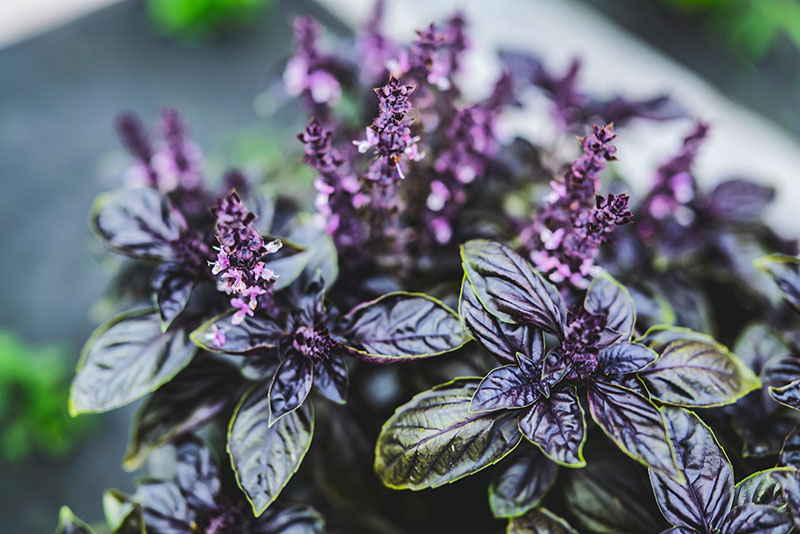
Edimentals Explained by Harris County Master Gardener
Article and photos by Terri Simon, Harris County Master Gardener
Edimental. I’m not sure who coined the word, but now that I’ve heard it I am not likely to forget it. The word is a fusion of two words, edible and ornamental. Edimentals are plants that are edible as well as being attractive. An edimental bed is planted for beauty and nourishment. There is also the hope that Home Owner Associations (HOAs) might be a little more lenient in regards to gardeners who plant edimental gardens in their front yard.
There are many types of foods a gardener can place in an edimental bed. There are herbal edimentals, vegetable edimentals, fruit edimental beds or a combination of any of the above. We have so many plant varieties available to us that it’s only natural that some plants can be edible and beautiful. Beauty is in the eyes of the beholder and edible gardens naturally draw your eye to them. The fact that they can be harvested and eaten is a plus. You can select perennial edimentals or annual edimentals or a combination. The choices are unlimited. There are also “theme” edimental gardens you can plant. One of my favorites is a pizza edimental bed suggested by Cheryl Beesley in her book Landscaping with Edible Plants in Texas. Imagine a bed edged with variegated thyme and filled with spicy globe basil, pesto perpetuo basil, dark opal basil, garlic, onions, oregano, and various peppers. I can practically smell the pizza already! The color combos would be fantastic.
Another edimental bed that comes to mind would be a bed with vegetables or spices used in Asian cooking. Hedou tiny bok choy used as a border, ginger root, some chijimisai and lemon grass. Chijimisai is a hybrid green I fell in love with last winter. It is offered from Baker Creek like the Hedou tiny bok choy. It is a cross of tatsoi and komatsuna and is loaded with vitamin A. Chijimisai is velvety and can be grown year round as long as the weather is not extremely hot. I will be starting some soon because while I grew it last winter, I want to see if it can handle any Texas heat. It can be eaten raw or cooked. I enjoyed mine both ways and loved it. It has a taste similar to spinach. I used it raw in salads and even threw a few shredded leaves in my scrambled eggs. The Hedou tiny bok choy is adorable and delicious and I used it in a big batch of wonton soup. That one’s definitely a keeper. Small, round, purple Vietnamese eggplants contribute to a beautiful bed. Cilantro works well in this garden bed as well.
Herbs also brighten up an edimental bed. I have already mentioned variegated thyme draped along the border. Pesto pertuo basil is my all time favorite basil I grow every year. It is not available in seed form because it is sterile. I grow several types of basil every year because I love it. Holy basil, Everleaf Thai towers, dark opal purple, Chinese sweet, Genovese, lettuce leaf, purple ruffle basil and cardinal basil are a few varieties I am growing this year. Cardinal basil is not only edible but it is a show stopper in the bed and can be used for cut flowers. Prostrate rosemary, Arp, Gorizia, salem and barbecue rosemary are a few of my favorites I have grown in the past and are perfect for an herbal bed. I am fond of barbecue rosemary because it has stems that can be used for barbecuing. Oregano, variegated thyme, parsley, lemon balm, chamomile, lemon grass, chives, cilantro, dill, stevia, Mexican mint marigold and fennel work great in an herbal bed. A new oregano hybrid called “Drops of Jupiter” is out and it is stunning. Bronze fennel with its coppery, feathery fronds that sway gently in a breeze can be included. It’s on my favorites list.
Don’t forget you can have a fruit edimental in your yard. Strawberries, blueberries, dewberries or blackberries are perfect for children. Trees can also be included in landscaping. Citrus trees can provide fruit and the scent from citrus flowers is wonderful. Fig, apple, plum, mulberry and others look great in landscapes. One tree I see frequently in front yards around town is a loquat tree. They are prolific and can be eaten out of hand or baked. They can also be canned into preserves, jelly or jam.
According to the Juniper Level Botanic Garden blog, when using edimentals, make sure you eat the correct part of the plant. Research the plant before eating it. Seeds, seed oil, roots, stems, bulbs, bark, pith, leaves, fruits, pollen, nectar, flowers, flower buds and fruits are all considered plant parts. Some parts may be consumed, but not others. Never consume plants that have recently been sprayed. Always refer to the package insert of the product you are using before consuming any part of the plant. One good reference for the edimentals is the “Plants for a Future” website, www.pfaf.org. The main reference I used for this article is Cheryl Beesley’s book I listed above. If you feel you have an outstanding “edimental” please submit it to us at the Urban Dirt. You are entitled to bragging rights.
Source: Harris County Master Gardeners Urban Dirt Newsletter (May 2023 Edition)
About Urban Dirt
Each month, Harris County Master Gardeners publishes an informative, resourceful newsletter entitled "Urban Dirt". This article was derived from the May 2023 edition. To read the May 2023 edition of this newsletter, click the button below.









